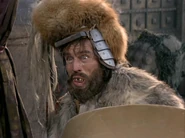Rigel VII was the seventh planet in the Rigel planetary system. This inhabited world had a Class M atmosphere and was the homeworld for a pre-warp capable species, the Kalar. The Vega colony was located near this planet. (TOS: "The Cage", "The Menagerie, Part I")
In 2254, a landing party from the starship USS Enterprise, led by Captain Christopher Pike, visited Rigel VII. While inside an apparently abandoned fortress, Pike and crew were attacked by the native Kalar warriors. Three crew members, including Pike's personal yeoman, were killed. Seven more were injured (including Spock, Navigator Tyler and a ship's geologist); some of these were so severely wounded that they required treatment at the Vega colony. Pike later regretted his decision to enter the fortress, stating that "the swords and the armor" should have alerted him to the possibility of a trap. (TOS: "The Cage", "The Menagerie, Part I", "The Menagerie, Part II")
There was a song called "Moon over Rigel VII," apparently inspired by a large, natural satellite orbiting the planet. Captain Kirk proposed singing it around a campfire while taking shore leave at Yosemite National Park on Earth with Captain Spock and Doctor McCoy in 2287. (Star Trek V: The Final Frontier)
During the 2360s, Kobliad fugitive Rao Vantika used a subspace shunt to access and purge everything in the active memory of computer systems on Rigel VII. He later attempted the same on Deep Space 9 in 2369. (DS9: "The Passenger")
A view of the surface of Rigel VII was depicted on several viewscreens on Deep Space 9's Promenade and replimat, (DS9: "The Muse") advertising a visit to the "spectacular castles of Rigel VII". (DS9: "What You Leave Behind")
Template:RigelSystem
Appendices
Background information
In Star Trek canon, the Rigel system was located within 90 light years of the Sol system. In 2151, Humans would adopt the name of this system from the Klingonese into their language and would know the location of this system from Vulcan star charts. This system was on a direct alignment between Earth and Argelius II. (ENT: "Broken Bow", "Two Days and Two Nights"; TOS: "Wolf in the Fold")
Behind the Scenes
In the story outline for "The Cage" (as reprinted in The Making of Star Trek, pp. 47-65), this planet's name was given as Endrex II. (The Making of Star Trek, p. 51) Analysis of the script for "The Cage" indicates that the planet's name was then changed to Rigel 113. Before it finally became Rigel VII, Harvey P. Lynn – a physicist from the RAND Corporation who served as an unofficial adviser on both "The Cage" and, later, the first season of Star Trek: The Original Series – suggested to Gene Roddenberry that he consider changing Rigel 113 to Vega 113, due to Rigel being "mighty far away." (The Making of Star Trek, p. 95)
In the second revised final draft script of "The Cage", it is notated that the Rigel fortress "suggests a medieval civilization, but carrying strange symbols and odd décor which suggests things quite alien from Earth." The script similarly describes the fortress' courtyard; "The feeling here is as outside, a feudal-level civilization but with its weapons and architecture somewhat different from Earth."
In "The Cage" and "The Menagerie, Part II", the surface of Rigel VII, including the exterior of the Rigel fortress, was depicted with a matte painting that was created by Albert Whitlock. The Rigel fortress' exterior also involved live-action footage that was filmed on the Metro-Goldwyn-Mayer backlot and the fortress' interior was a set. ("The Menagerie, Part II" text commentary, TOS Season 1 DVD) The matte painting used to depict Rigel VII was re-used, unaltered, for Holberg 917G in the original version of TOS: "Requiem for Methuselah" (though it was replaced by a new CG matte painting for that episode's remastered version).
"The Explored Galaxy"
This chart was first seen, chronologically, in 2293. (Star Trek VI: The Undiscovered Country) This star chart was also seen in several Star Trek: The Next Generation and Star Trek: Deep Space Nine episodes set in the 24th century, from the year 2364 to 2370. These were: TNG: "Conspiracy", "The Measure Of A Man", "The Emissary", "The Mind's Eye", "The Game" and DS9: "In the Hands of the Prophets", "Cardassians".
Star Trek: Star Charts
According to this non-canon reference book (pgs. 36, 54, 59, 60), Rigel VII was a quarantined planet. This planet was a Class M world. The world was not ruled by a uniglobal government, and the planet was non-aligned. This political status might change with the development of warp drive. This planet didn't have a uniglobal capital. The dominant species was the humanoid Kalar. There were an estimated count of 725,000 Kalar in 2378. First contact with this world was made by the USS Enterprise in 2254.
The Rigel (or Beta Rigel) system was a single star system. Beta Rigel was a A5V star with an absolute magnitude of 6.2. In 2151, the Enterprise visited this system. In 2152, this system was located in non-aligned space. Between 2152 and 2378, this system was incorporated into Federation space, and was a destination on the major space lanes.
Note: Facts that either contradict the canon or were in question were omitted from this summary.
Apocrypha
In the short story version of "The Cage" (titled "The Menagerie" and published in Star Trek 4), this planet's name was Rigel VIII.
According to the comics series Star Trek: Early Voyages, the building was named the Zemtar fortress, and the Kalar warriors attacked because of their reluctance to see their homeworld join the peaceful Federation. None of these facts were derived from any actual production information, however; they were instead devised solely for the non-canon comic.
In Decipher's Star Trek Roleplaying Game, the green Orion race was from Rigel VII.
External link
- Template:NCwiki

